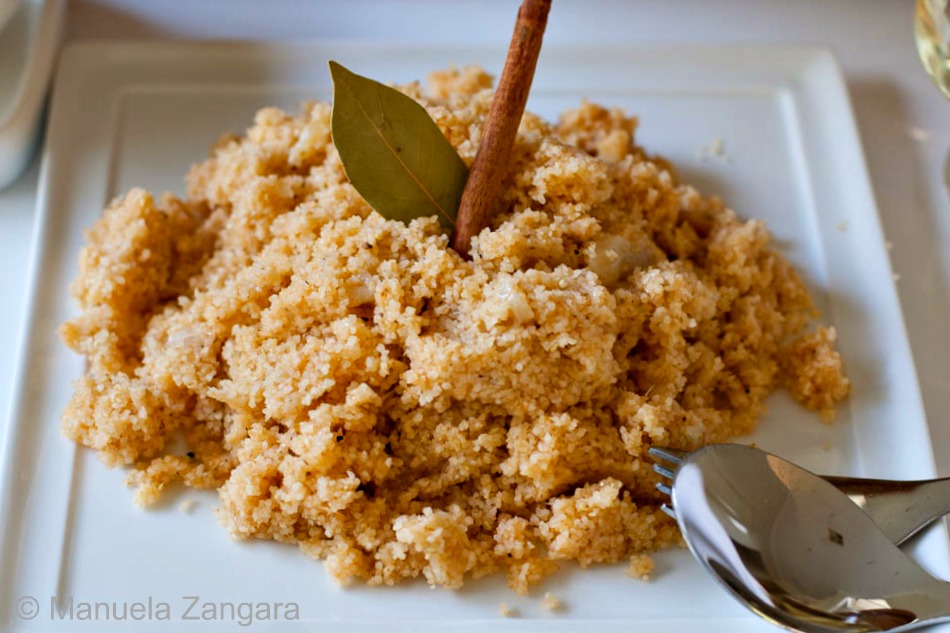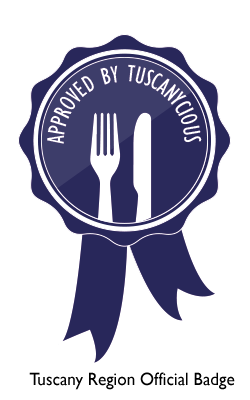I finally get to share with you what we ate on Christmas day and one of my all time favourite dishes: fish couscous. It is a traditional and ancient recipe from Trapani, the town in Western Sicily where my mum is from. In fact, this is a “guest post from my mum” who is presenting to my readers my grandma’s recipe! It is a dish of clear Arab Berber origin adapted to the territory and the local produce. Trapani is a town by the sea where fish has always been the staple diet. This is a so called “poor dish”, as it used to be made with cheap and easily available ingredients: semolina, fish, extra virgin olive oil, onions and garlic. It has since become a very popular dish, famous throughout Italy (and beyond). In fact, it is so famous that an international event called Couscous Fest is held every year in the seaside village of San Vito Lo Capo, the place where I spent many summer holidays. During the days of the festival, chefs from many Mediterranean countries cook their best couscous for people to enjoy. This is the real deal… not the pre cooked store bought couscous. It takes longer to make, but it tastes so much better! You should give it a try… you’ll never go back, believe me! Enjoy and don’t forget to enter my giveaway for a chance to win a $50 or a $25 Amazon.com gift card!
For the fish broth
Ingredients:
1.5 to 2 kg – 3.3 to 4.4 lbs fish for soup, cleaned and salted (but WITH the heads on)
7-8 garlic cloves
3 medium onions, minced
1 tbsp parsley, chopped
1 small tin double tomato concentrate
10 tbsp extra virgin olive oil
½ to ¼ tsp salt (to taste)
4 lt – 135 oz. water
Start by crushing together ½ of one onion, all the garlic cloves and parsley in a mortar and pestle. Keep aside.
Mince the rest of the onions and sauté it gently in a big pot together with the extra virgin olive oil (1). Do this on a very low fire. The onions have to become transparent and not brown. After 5 minutes, add the crushed garlic, onion & parsley mixture (2) and cook for another 3 or 4 minutes. Add the tomato concentrate (3), mix well and cook for a couple of minutes. NOTE: my grandmother would take 2 or 3 tbsp of this mixture and keep it aside to be used at a later stage. Now add the water (4) and bring to a boil. Add the fish and salt (5) and simmer on a low fire for about 1 hour (6).
NOTE: the cooking time will depend on the size of the fish you are using. If you are using bigger fish, I suggest you cut them in half (horizontally) and remove the tail parts after cooking them for 30 minutes, so you can eat this fish later with the couscous. Keep simmering the stock with the heads (which can be discarded later). If your fish was small to begin with, it will melt away in the stock, so do not worry about it.
Sieve the stock and keep it aside (you can add the fish to it later on).
For the couscous (serves 6 to 8 people)
Ingredients:
For the “’ncucciatura”
1 kg – 2.2 lbs semolina*
5 bay leaves
2 medium onions, roughly chopped
250 ml – 1 cup salted water (add between ½ to 1 tbsp salt to it… it has to be salty like the water used to cook pasta in. Also, you may no need all of it.)
½ tsp pepper, freshly ground
200 ml – 7 oz. extra virgin olive oil
*this semolina has to be about 1 mm – 0.04 inches thick BEFORE cooking it.
For steaming
Water to cook in the steamer
5 cloves garlic
10 pepper corns
2 bay leaves
½ cinnamon stick
Flour and water to seal the steamer
The first step to make couscous from scratch is to actually transform the semolina grains into couscous (which are bigger pellets of semolina). This process, in Sicilian, is called “’ncucciata”.
To do so, you need a big bowl with wide sides. I use a traditional terracotta bowl that I brought from Trapani, called mafaradda. Start by putting a couple of handfuls of semolina in the bowl (1) and 2 or 3 spoonfuls of the salted water (add it slowly, you don’t want a soggy mixture, but just enough water to aggregate the pellets) and mix them well with your hand (2-3-4), in a circular movement, making sure there are no lumps. The semolina will turn into pellets pretty fast. They have to be 2 to 3 times bigger than the semolina grains you started with (5).
It sounds much more complicated than it really is. Here is a video I took of my mum making it.
When ready, put it into a cuscusera and repeat until you run out of semolina (6). I use the traditional terracotta pot with holes at the bottom, but I have also seen a more modern version called couscoussier. It is basically a “double-chambered food steamer used […] to cook Couscous. It is typically made of two interlocking metal pots. The first, larger pot, holds water used to make steam. The smaller pot, which is placed on top and has a lid, is perforated on the bottom so that it holds the couscous in place while allowing steam to enter.”
Then put all the couscous back into the mafaradda, add the ground pepper (1) and bay leaves. Add 200 ml – 7 oz. of extra virgin olive oil (2) and mix well with your hand, in a circular movement, making sure there are no lumps (3). Add the roughly chopped onions and mix well (4). Put it back into the cuscusera.
Then take the larger pot and fill it with water. Add the garlic cloves, cinnamon stick, pepper corns and bay leaves.
Place the smaller pot with holes with the couscous on top of the bigger pot filled with water (make sure the water does not touch the pot with the couscous in it). To make sure no steam comes out of the big pot, make a little sticky dough with flour and water and stick it all around the joint between the 2 pots.
Put the pots on the fire. Start with a high flame for 10 minutes, to help the boiling process. Then reduce the flame to the minimum and let it cook, partially covered, for 1.5 hours from when the water starts boiling. Stir the cous cous every now and then so that the steam gets evenly distributed.
In the meantime, clean the mafaradda (I also use it as a serving plate). When the couscous is cooked, put it in the mafaradda.
Drizzle with some extra virgin olive oil and more than half the fish stock (and the garlic, onion, parsley mixture you kept at the beginning – optional). The couscous at this stage has to be wet. The stock will get absorbed while “resting”. Mix well and cover it completely with a cover or towels. It has to remain HOT. Let it rest for 1.5 hours.
Serve with the remaining fish stock on the side and the fish you had kept aside on the top (optional).
The best way to eat it is to add a little more stock to the couscous on your plate.


































My Sicilian mom made this and she called it “Couscouszoo.” Thanks for sharing. I’ve made it before, but a long, long time ago. This will refresh my memory.
I know this is an old thread but I’ve been looking for couscouszoo for many years. My husbands grandmother made it clear with steamed cream of wheat, which went on the bottom of the bowl then the broth and fish on the side. No mention of any tomatoes. Do you remember what she put in her soup? The family pronounced this the same as you. Thanks and I hope I this gets to you.
What a wonderful recipe and the family history makes it that much better. Excellent job!
I have a big bag of couscous in my pantry, and I cant wait to try this recipe, it sounds so good! Thanks for sharing about the traditions and your mom’s cooking. This is what makes cooking so special to me
I love couscous but never tried a fish one. Thanks to you and your mum for showing us a traditional family recipe. The Couscous Fest sounds like something I would love.
P.S. Thanks for participating in the YBR
Couscous from scratch! Will you laugh at me if I said that I didn’t even know that was possible? LOL 😀 Your mom is obviously a fabulous cook… It looks really delicious! And I love how much learning I got from this post! 😀
What a lovely couscous! This version sounds and looks really wonderful.
Cheers,
Rosa
I see that you are making the couscous in the traditional method and not using the ‘instant’ kind that is so easily purchased. We learned how to make this in Morocco in one of the cooking courses we took — I had no idea it was so labour intensive. The fish addition sounds wonderful. I will bookmark this, your mom’s instructions as the cooking class we learned how to make couscous traditionally did not hand out instructions after ward. Thank you!
Ah you are so lucky your mom is a great cook too! This is such a cool cooking technique and tool and I wanted to watch the video clip of your mom’s entire cooking! I bet this was very delicious. Don’t you miss your mom’s cooking already? Hope she’ll come back soon and share us her recipes again!
Very Interesting..love the idea and recipe too! Your mom did fantastic job..
Thank you for sharing video too..I appreciate it! Have a lovey day Manu!!!!
Wow! What a great dish! I’m sure it tastes much better than the pre cooked version. Sooner or later I will have tor try this technique!
I wanna go to Sicily! I would die for this cous cous!!
Manu, thank you for sharing this dish with us! I have never tried anything like this before 🙂
Manu you never cease to amaze me with the originality of your cooking…your dishes are an absolute inspiration and this is no exception!
Wow! Gorgeous! I had no idea about this cooking technique at all, but the flavors sound stunning and like I should put this on my bucket list for fancy occasions 🙂 Great, informative post!
I love couscous di pesce. It is always a special day when my mother in law makes it. She, too, makes the couscous herself and fries some calamari to eat alongside. She also makes rings out of the left over dough that she uses to join the two pots…but I can’t remember what they are called. Maybe you know? This looks exceptional (complimenti alla mamma): I bet it was a really special Christmas meal. Did you bring the mafaradda all the way from here?